#high mast cables
Explore tagged Tumblr posts
Text

premium silicone cables manufacturers in india
0 notes
Text
Glossary of Nautical Terms - as used in the late 18th and early 19th centuries
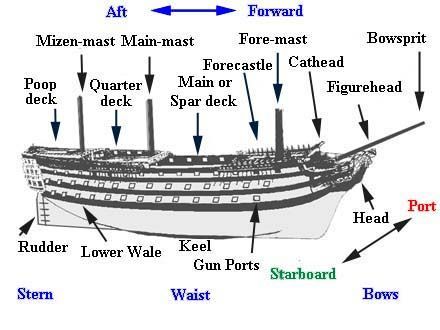
Aft: at or towards the stern or after part of a ship, the opposite of bow.
Aloft: overhead, or above.
Athwart: across.
Bank: a rising ground in the sea, differing from a shoal, because not rocky but composed of sand, mud or gravel.
Becalmed: to halt through lack of wind.
Bow: the foremost end or part of a ship, the opposite of stern.
Bowsprit: a large mast or piece of timber which stands out from the bow of a ship.
Burthen: the older term used to express a ship's tonnage or carrying capacity. It was based on the number of tuns of wine that a ship could carry in her holds, the total number giving her burthen.
Chase, to: to pursue a vessel in wartime with the aim of capturing, acquiring information from her, or destroying.
Colours: the name by which the national flag flown by a ship at sea is known, used to determine nationality.
Dead reckoning: a system of navigation where the position of a ship is calculated without the use of any astronomical observation whatever.
Fair wind: a wind favourable to the direction a ship is sailing.
Fathom: a measure of six feet, used to divide the lead (or sounding) lines in measuring the depth of water; and to calculate in the length of cables, rigging, etc.
Fore: the forward part.
Hail, to: to call to another ship.
Helm: the instrument by which the ship is steered, and includes both the wheel and the tiller, as one general term.
Jib: a triangular sail set by sailing ships on the boom which runs out from the bowsprit.
Jury-mast: a temporary makeshift mast erected to replace a mast that has been disabled or carried away.
Jury-rudder: a makeshift arrangement to give a ship the ability to to steer when she has lost her rudder.
Keel: the lowest and principal timber of a wooden ship - the single strongest member of the ship's frame.
Knot: the nautical measure of speed, one knot being a speed of one nautical mile (6,080 feet) per hour. As a measure of speed the term is always knots, and never knots an hour.
Landfall: the discovery of the land.
Land-locked: sheltered all round by the land, so that there is no view of the sea.
Lead: an instrument for discovering the depth of water, attached to a lead-line, which is marked at certain distances to measure the fathoms.
Lee: the side of a ship, promontory, or other object away from the wind; that side sheltered from the wind. It is the opposite side to windward.
Lee shore: a coastline on to which the wind blows directly - consequently it can be dangerous as the wind tends to force the sailing ship down on it.
Leeward: with the wind; towards the point to which the wind blows.
Letter of Marque: a commission issued in Britain by the Lord High Admiral or Commissioners of the Admiralty authorizing the commander of a privately owned ship to cruise in search of enemy merchant vessels. The letter of marque described the ship, her owners and officers, the amount of surety which had been deposited and stressed the necessity of having all prize vessels or goods seized condemned and valued at a Vice Admiralty Court for the payment of 'prize money'.
Lie-to: to prevent a vessel from making progress through the water - achieved by reducing sail in a gale. The objective is to keep the vessel in such a position, with the wind on the bow, as to ensure that heavy seas do not break aboard.
The Line (or 'Crossing the Line') Sailing across the Equator. Nautical tradition where seamen celebrate the crossing of the equator by dressing up and acting out a visit by King Neptune. Those who have not previously crossed the line are summoned to the court of Neptune for trial, followed by a ritual ducking (in a bathing tub of seawater) and sometimes lathered and roughly shaved.
Mainsail: the principal sail of a sailing vessel.
Mizzen (or mizen): the name for the third, aftermost, mast of a square-rigged sailing ship or of a three-masted schooner.
Muster: to assemble the crew of a ship on deck and call through the list of names to establish who is present and accounted for.
Muster-book: the book kept on board a vessel in which was entered the names of all men serving in the ship, with the dates of their entry and final discharge from the crew. It was the basis on which victuals were issued and payment made for services performed on board.
Pintle: a vertical metal pin attached to the leading edge of the rudder; it is fitted into the metal ring or 'gudgeon' bolted to the sternpost of a vessel. This provides the means for hinging the rudder on the sternpost and allows a rudder to be swung or turned as desired (by use of the tiller); where necessary (ie. when the rudder needs to be removed or repaired) the pintles can be unshipped quickly and the rudder detached.
Port: the left-hand side of a vessel as seen from the stern; also a harbour or haven.
Privateer: a privately owned vessel armed with guns which operated in time of war against the trading vessels of an enemy nation. Each privateer was given a a 'letter of marque' which was regarded as a commission to seize any enemy shipping as a 'prize'. The name 'privateer' has come to refer to both the ship and the men who sailed in her.
Prize: name used to describe an enemy vessel captured at sea by a ship of war or a privateer; also used to describe a contraband cargo taken from a merchant ship. A 'prize court' would then determine the validity of capture of ships and goods and authorize their disposal. 'Prize' in British naval history always acted as considerable incentive to recruitment with many men tempted to join the navy in anticipation of quick riches.
Prize Court: Captured ships were to be brought before prize courts where it was decided whether the vessel was legal prize; if so, the whole value was divided among the owners and the crew of the ship.
Prize Money: the net proceeds of the sale of enemy shipping and property captured at sea - these proceeds were distributed to the captors on a sliding scale from highest rank to lowest seaman.
Road or Roadstead: a stretch of sheltered water near land where ships may ride at anchor in all but very heavy weather; often rendered as 'roads', and does not refer to the streets of a particular port city but rather its anchorage, as in 'St Helens Roads', the designated anchorage for shipping located between St. Helens (Isle of Wight) and Portsmouth, or 'Funchal Roads' at the island of Madeira. (see Elizabeth Macquarie's 1809 Journal).
Quarter: (1)the direction from which the wind was blowing, particularly if it looked like remaining there for some time; (2)the two after parts of the ship - strictly speaking a ship's port or starbord quarter was a bearing 45° from the stern.
Ship: from the Old English scip, the generic name for sea-going vessels (as opposed to boats). Originally ships were personified as masculine but by the sixteenth century almost universally expressed as as feminine.
Shoal: a bank or reef, an area of shallow water dangerous to navigation. Sounding: the of operation of determioning the depth of the sea, and the quality of the ground, by means of a lead and line, sunk from the ship to the bottom, where some of the sediment or sand adheres to the tallow in the hollow base of the lead.
Sound: (1) to try the depth of the water; (2) a deep bay.
Sounding: ascertaining the depth of the sea by means of a lead and line, sunk from a ship to the bottom.
Soundings: those parts of the ocean not far from the shore where the depth is about 80 to 100 fathoms.
Spar: a general term for any wooden support used in the rigging of a ship - includes all masts, yards, booms, gaffs etc.
Squall: a sudden gust of wind of considerable strength.
Starboard: the right-hand side of a vessel as seen from the stern.
Stern: after-part of a ship or boat.
Tack: the nautical manouevre of bringing a sailing vessel on to another bearing by bringing the wind round the bow; during this manouevre the vessel is said to be 'coming about'.
Tide of Flood: the flow of the tidal stream as it rises from the ending of the period of slack water at low tide to the start of the period of slack water at high tide; its period is approximately six hours.
Trade Winds: steady regular winds that blow in a belt approximately 30 N. and 30 S of the equator. In the North Atlantic the trades blow consistently all year round, from the north-east; in the South Atlantic they blow from the south-east, converging just north of the equator. The meeting of the trade winds just north of the equator created the infamous 'doldrums', where sailing ships could be becalmed for days or weeks waiting for a wind to carry them back into the trades.They were known as trade winds because of their regularity, thereby assisting sailing vessels in reaching their markets to carry out trade.
Under way: the description of a ship as soon as she begins to move under canvas power after her anchor has been raised from the bottom; also written as 'under weigh.'
Voyage: a journey by sea. It usually includes the outward and homeward trips, which are called passages.
Watch: (1) one of the seven divisions of the nautical day; (2) one of two divisions of the seamen forming the ship's company.
Wear: the nautical manouevre of bringing a sailing vessel on to another tack by bringing the wind around the stern.
Weather: in a nautical sense (rather than a meteorological) this is the phrase used by seamen to describe anything that lies to windward. Consequently, a coastline that lies to windward of a ship is a weather shore; the side of a ship that faces the wind when it is under way is said to be the weather side a ship, etc.
Weigh: to haul up.
Weigh anchor: the raising of the anchor so that the ship is no longer secured to the sea or river bottom.
Windward: the weather side, or that direction from which the wind blows. It is the opposite side to leeward.
Yard: (1) a large wooden spar crossing the masts of a sailing ship horizontally or diagonally, from which a sail is set. (2) a shortened form of the word 'dockyard, in which vessels are built or repaired.
Sources: JEANS, Peter D. Ship to Shore: a dictionary of everyday words and phrases derived from the sea. Santa Barbara: ABC-Clio, 1993.
The Oxford Companion to Ships & the Sea. (ed.) Peter Kemp. Oxford: Oxford University Press, 1976.
#naval history#naval artifacts#ship terms#not from me#sources below#18th century#19th century#age of sail#infos
1K notes
·
View notes
Text
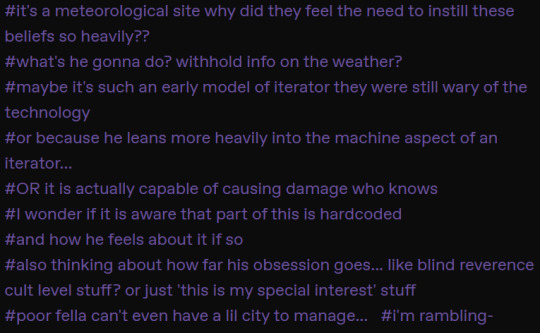
(tags from @beeb-oob I hope you don't mind me tagging you here so you can see my extra rambling)
TLSPTS indeed is a meteorological superstructure- but more than that, he was a symbol, as many iteraors were during the times from Prototypes to First Mass Construction Wave.
Network - Ah, this one is quite old ! It predates the construction of Twenty Long Spears Pierce the Sky, as it seems to have been recorded during the installation of additional access ports to the Meteorological Superstructure's network. Although it does look like the implementation of an Iterator to the station was already being suggested at the time, under the project name of Display of Power. The rest of the data is only comprised of intricate maps, which I doubt would be of great interest to a little creature like you.
"Display of Power" or "Supremacy of [Concerned House]" (which became "Supremacy of House of Concerns") were two draft names for project Twenty Long Spears Pierce the Sky. It should give you the general idea behind his construction. As iterators were starting to be mass constructed, they became a major tool in displays of religious and political influence. Those which were not Community-constructed (common accord between multiple Houses or Organizations) could be used as the ultimate sign of "being better" than everyone else.
-> I explain the construction waves in this post if you're interested
When you make a product, you need a form of control over it. You want it to spread and promote specific ideas, ideologies, principles, models and systems. And you certainly want it to see you (and present you) in a good light.
It was also a good way to test certain things before implementing them on future models.
Regarding how a meteorological superstructure would be capable of causing damage- there's a few things !
Twenty Long Spears Pierce the Sky is an Unconventional Model - High Processing Power. He was constructed to monitor the Great Equalizer (when it hadnt stabilized yet and when the mass construction of iterators were still heavily impacting the weather in a way that the Benefactors struggled to fully measure). It collects, processes and stores a gigantic amount of meteorological data, but also runs heavy simulations to estimate the impact of a construction (depending on the area) and its viability (construction impacted by nearby structures ? climate too dangerous for installation ? etc..).
Have it withhold the information, or make the machine generate false data and you start having a problem. He probably isn't the only meterological superstructure out there, but it certainly is one way to get in the way of a project the House is against.
As for something way more rare but quite problematic : mislabelled systems and the Physical Network Points.

Here we have a (poorly drawn) example of how TLSPTS is connected to distant meteorological masts. "Physical Relay" means it's a bunch of cables running underground (or above ground in massive protective layers) connecting various "Physical Network Points" (connection hubs, where multiple relays connect or can be connected). "Non-physical relays" are ones not connected by cables.
These masts are all labelled under "meteorological equipment".
In extremely rare cases, this can happen :
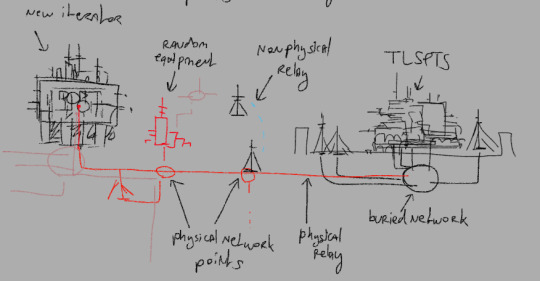
Random equipment is connected to the mast or replaces it, but remains attached to the network point under the same label. This can happen for iterator equipment too (though it's generally fixed if the mistake is caught) but would mostly happen to rushed projects.
Legally speaking, the data passing through these networks and marked as coming from "meteorological equipment" is fully accesible by TLSPTS. He is allowed to process and store it- or share it however he wants. Depending on the mislabelled equipment, that access can become more or less problematic.
-> Not canon but in a fun little rp, one poor iterator (Paths Left Untaken by @fauxbia) had the misfortune of having her internal temperature systems marked as "meteorological equipment". Not fun. Especially when her access to her own data could simply be denied due to it. (Also go look at PLU's design she is such a cool character)
Oh !! I almost forgot about the second part of the tags ! Regarding the Docility Protocols !
He isn't aware of them. He can't, either. A fun little aspect of the Protocols is that they prevent the iterator from recognizing them. You could show a comprehensible piece of code to him and he would not be able to recognize what it is, and it would leave his mind the second he's no longer focused on it.
As for how far the obsession goes ? Think of his general relationship with some Benefactors as a worshipper/god relationship ? Sort of ? So yes, "blind reverence cult" type of vibe. But it also becomes hyper possessive later on (post mass ascension).
-> Example (not canon, but still fun) : the skittering. He tore himself from the earth (and effectively disemboweled himself in the process) just to run after TWO Benefactors, who left to reside within another superstructure.
Also last little thing : he does not have a city because he lacks legs (the structure is sitting on top of an older meteorological station) and the top of the can is too close to the cloud layer. (And also the fact he just generates massive storms by breathing).
#rainworld#rain world#the outstorms#twenty long spears pierce the sky#look at me rambling again </3#THANK YOU BEEBOOB FOR THE QUESTIONS BECAUSE I FINALLY GET TO ACTUALLY WRITE DOWN MY LORE ELSEWHERE THAN IN SOME#RANDOM DISCORD SERVER OR SOMETHING
28 notes
·
View notes
Text
Chapter 214 Trivia
The two-part connected covers are so cool, I'm happy we got two colored ones in a row!
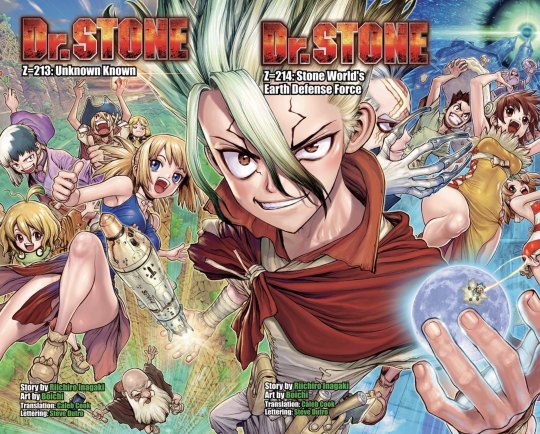
There's a sneaky rat (or mouse?) on the cover! Unfortunately I have zero idea what this could be alluding to. It could be nothing, or it could be implying that Ukyo (same colors) is the t(ra)i(t)or…
The inside of Xeno's scar is also colored white! New petri-scar theories?

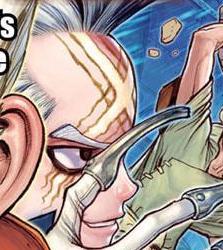
The name of the chapter is a reference to the Earth Defense Force (地球防衛軍) video game series. Its plot is that radio waves from deep space are picked up by scientists on Earth, and a multinational military is formed afterwards in case the aliens are hostile. Sound familiar?

Suika's helmet has a top part! I am wondering where it appeared from though.
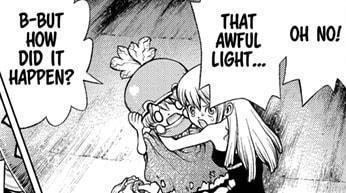
Before this moment, they'd always revived whole statues. If it's possible to revive an incomplete statue, and the missing pieces don't grow back as part of the healing effect of the depetrification, it means it's not the end for someone if they're missing a limb.

Senku is using his arm wrappings to pick up the device. I wonder why he suddenly felt the need to use them…

When glass containing a vacuum breaks, the pieces get sucked in along with the air suddenly filling the space at very high speeds. They then smash into the middle before shattering outwards again. Think of what happens when you drop a rock into a bucket of water!
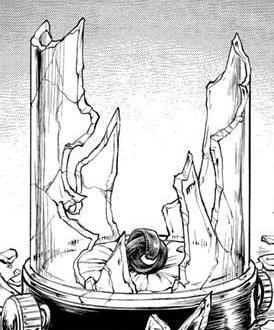
You may have noticed that the resulting glass doesn't quite follow what should have happened there, so the other possible option for how the glass shattered is thermal shock. Cracks of this type begin perpendicularly to the edge of it, which we can sort of see here.
In both cases, glass would have ended up on the inside of the container, but we see none. Could the medusa's pressure wave have thrown all the glass away from itself? And if that's the case, why are the glass walls still standing?


Chelsea: somehow stealing Suika's job and traits as much as possible. Why is it detective Gen!? Bring back detective Suika!



There's now a third boat donning the "Perseus" name: Perseus D. Monkey. This one is heavily inspired by One Piece, specifically the protagonist Monkey D. Luffy. The head of the ship is painted like a monkey: a reference to One Piece, the steam gorilla, and the old Perseus design.
The ship design itself is a smaller, more maneuverable version of the original Perseus. It's also a hybrid with an engine, and rather than having the whole mast rotate, they've designed it as a sailboat with a rotating boom.
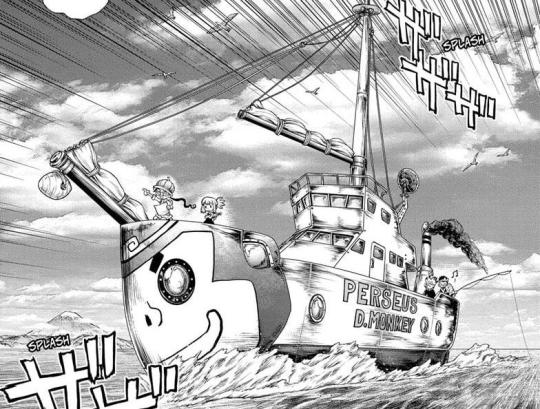
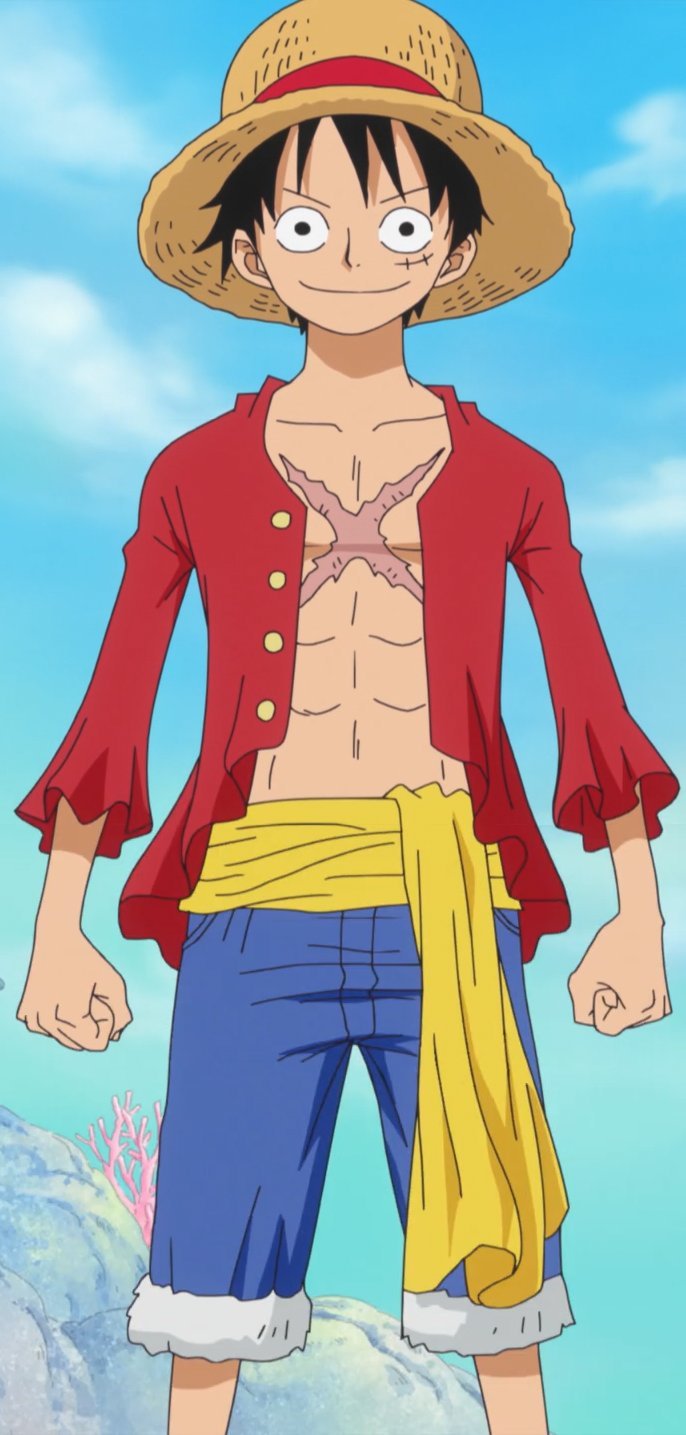
The Kagoshima prefecture mine they probably went to is the Kushikino mine, which is the only one that has selenium-silver ores (naumannite & aguilarite), but also has ores containing both arsenic and tellurium. Because the area is volcanic, there's likely several skarn deposits.
Kagoshima's mines are in fact most known for their gold deposits, so Senku is probably finding more to replenish Chrome's gold stash.

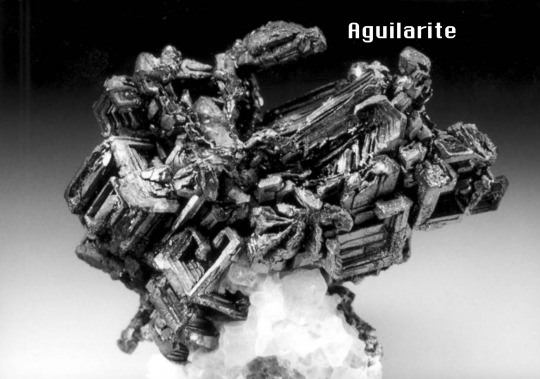

Senku's video camera tube is based off Japan's saticon from 1973. The "SAT" in its name is derived from "SeAsTe"; the symbols for the selenium, arsenic and tellurium used on its photoconductive (not photoelectric) surface.
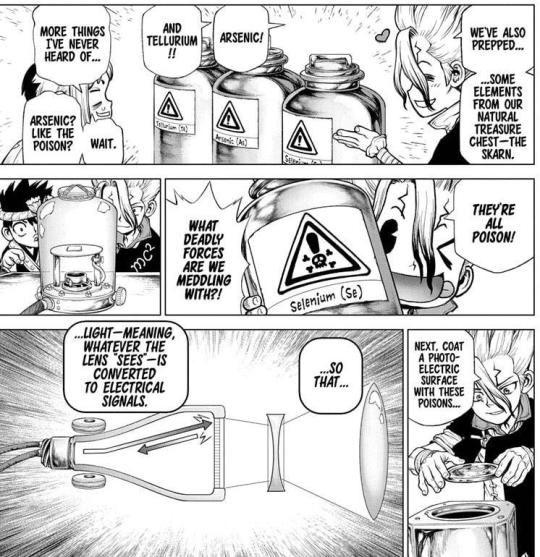
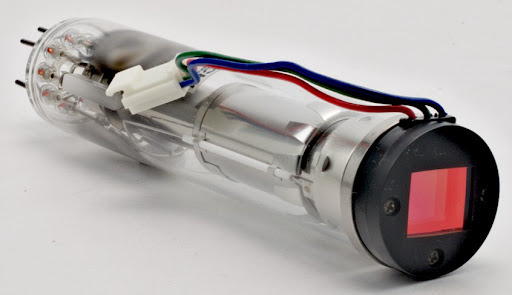
Remember the fax machine from chapter 207, how Senku said matching up the timing was important? Well the horizontal distortion in the image here is exactly the same concept: the horizontal lines are shifted to the left or right due to minor errors.


Before anyone says that Whyman can hack their television signal from the moon, remember that these are basically cable TVs, where you'd have to rewire it for a new input if you wanted it to display a different image. Anything sneaky would have to be an inside job…

We have the (Stan)Lee vs Xeno baseball game happening on the field outside the castle. Since the ball smashes through the window of the TV room, and the world record for longest baseball hit distance is 177m, you can tell the batters take after Stanley. (They can.)
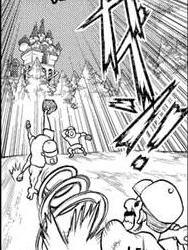

A reference to 20th Century Fox, one of the many names for one of the biggest American film studios.
Obviously, the 58th is a reference to their current year.


We got a better location on the computer's house, it's a lot closer to Roppongi than I first thought! I wonder how close it is to Senku's grave and Tsukasa's pile of statues that he wanted to revive…
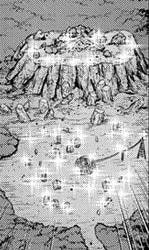
#trivia#dr stone#chapters#214#this and the previous chapter hold a special place in my heart because of a particular fanwork's setting :)
18 notes
·
View notes
Text
Rereading The Terror
Chapter Twenty: Blanky
Hickey’s background machinations continue and Blanky has absolutely no time for them: “He knew that some of the less educated men - centred around the caulker’s mate, Cornelius Hickey, whom Blanky has never liked nor respected - were spreading the word that the Thing on the Ice was some sort of demon or devil... some around Hickey were already making sacrifices to the monster, setting them outside the forward cable locker in the hold where everyone now knew Lady Silence, obviously an Esquimaux witch, was hiding. Hickey and his giant idiot friend, Magnus Manson, seemed to be the high priests of this cult - or rather, Hickey was the priest and Manson the acolyte...”
Not too much else jumps out at me in this chapter, to be honest. It’s mainly Blanky ruminating on recent events but it finishes with him dwelling on his own part in things and on his own guilt which is always interesting to me.
Chapter Twenty-One: Blanky
This chapter covers Tuunbaq’s attack which is much the same as the show for the most part. Blanky is out on deck with different men in this case and Tuunbaq chases him not only up the mast but then out onto the ice.
He is, of course, a consummate and sweary badass throughout - here’s a little quote that really made me laugh: “God-damn your eyes!” roared Thomas Blanky. “If you don’t retrieve that weapon this gob-fucking minute, a flogging of fifty from the cat will be the least bugger-fucking thing you have to worry about, John Handford. Now, move!” Just scolds the poor guy like a big angry mother hen, full name and everything! Outstanding! And he carries on doing it! “Just stay where you are,” snapped Blanky... “Don’t shoot me when I come back with Leys or I swear to God my ghost will haunt you ‘til you die, John Handford.”
He is wrong about one thing though - he fully believes that Tuunbaq won’t be able to climb the mast which makes the moment it does start clambering up after him all the more gut-wrenching. Interestingly, Blanky himself also ends up doing various heroic things and climbing up various ropes that he admits himself shouldn’t be possible to do which is a great and sneaky little parallel between him and Tuunbaq.
Ooh actually, there is one more thing he’s wrong about: “At that instant Thomas Blanky realized that the seaman whom he’d silently cursed as being superstitious fools had been right; this thing from the ice was as much demon or god as it was animal flesh and white fur. It was a force to be appeased or worshipped or simply fled.”
That being said, by the time it chases him out onto the ice he’s not all that bothered after all about appeasing it: “Blanky’s last prayer was that one of his bones would lodge in the thing’s throat.”
Interesting, it’s Hickey to the rescue again though he’s not bashing caulk off a door this time, he’s slipping through the tiny gap into the ice-cave Blanky’s found himself in because he’s the only man small enough to fit. Blanky thinks it’s “like watching a gimlet-faced gnome being born.”
Two last little minor things, one that feels very out of place and anachronistic - Mr Reid cajoling Blanky saying “Your grandkids will love them scars”- and one that punched me right in the gut - mention of Blanky reading ‘The Vicar of Wakefield’ which we may remember was later found torn, exposed, and windblown out on King William Island IRL.
#The Terror#The Terror AMC#Observations#Random Observations#Meta#Rereading The Terror#Thomas Blanky#Cornelius Hickey#Tuunbaq#Can we start calling him a gimlet-faced gnome instead of a caffeinated saint please?
15 notes
·
View notes
Text
Tobermory Bay
John Douglas Sutherland Campbell
In the vapour and haze on the ocean, Where the skies and the waters meet, There's a form that drifts, phantom-like, onward As it follows the grey clouds' feet.
O'er the sea come the winds and the billows, And they howl to the rocks, and they cry, They will bring them a wreck on the morrow, Ere the joy of the tempest die.
The shade looming dark in the distance Is naught but a galleon proud; And the spray has long battered her turrets, And loosened each yard and each shroud;
But not on the surf-beaten islands, Nor yet upon Morven's land, Does she drive, for her rudder, unshattered, Is firm in the steersman's hand.
No mist wreath, no cloud, was the shadow That moved on the height of the seas; Like a castle how steep are her bulwarks, Her spars like a forest of trees!
She is safe from the gales for a season, In the shelter and calm of the sound; A harbour named after the Virgin, The "Well of Our Lady" she found.
She may rest in that haven, hill-girdled, Near the shade of the woods on the shore, Where the hush of the forest is deepened By the waterfall's song evermore.
How grandly her masts rise to heaven, How glitters the blest Mary's form, High placed o'er the stern, and upholding The Prince of our Peace through the storm!
Now waters their orisons murmur As they fold her bright robes to their breast, Where they mirror the galleried windows, And the flag and the face of the Blest.
Again with that sign and the banner Of the gold and the crimson of Spain, Shall this ship front the foes of the Virgin, And the English be chased from the Main.
Yes, again on the heretic Saxon Her cannon shall thunder in scorn, Till in triumph through insolent England Shall the Faith and King Philip be borne.
But the rows of dark mouths that have spoken Defiance with sulphurous breath, Glisten black, stretching forth in the silence, And in vain ask the presence of death.
Yes, repose and surcease of all hazard, A truce to all war for a time! The cliffs and the pines only echo The laugh of a sunnier clime.
And gaily the dark-visaged seamen Quaff, cursing the mists and the rain; Gravely drinking from goblets of silver Sits their chief, Don Fereija of Spain.
But the souls of the men to whose nostrils Had risen the smoke of the fight, Soon tired of the shore and of slumber, Soon yearned for the red battle light.
And courtesy fled from the weary, From idleness arrogance grew; And all they received as a favour They haughtily claimed as their due.
Then answered the Islesmen in anger, "The food you demand as your own, By our people's free favour long given Shall be bought by your gold now alone."
"Now, down with the savage's envoy, Set sail and away on our track! Carthagena's sweet girls shall deride him, And jeer the red locks on his back."
Below, in the dark narrow spaces, The Islesman gropes, down in the hold; Unnoticed, and one among many; What harm can his hatred unfold?
Swarm the men to the rigging, and swiftly Shine clouds of white canvas, and clank The links of the anchor's great cable, Creaks, trampled on deck, every plank:
Swings round the huge bowsprit, and slowly With motion majestic and free, The galleon, vast, gilded, and mighty, Passes on, passes forth, to the sea.
Her colours still paint all the ripples, Repeated her banners all seem, Her sails, and her gold, and her cannon Float on like a gorgeous dream.
Came a flash, and a roar, and a smoke-cloud Rushed up, and spread far o'er the sky; Sank a wreck, black, and rugged, and blasted, While the sound on the winds swept by.
And the mountains sent back the dull thunder As though to all time they would tell The vengeance that pealed to the Heavens From the Harbour of "Mary's Well."
#poetry#sinking#spanish galleon#John Douglas Sutherland Campbell#wreck#tobermory#Isle of Mull#armada
2 notes
·
View notes
Note
Happy WBW!
Tell me more about the world of the Millennium Saga: what sort of steampunk technology is commonplace? What isn't? What are its limits?
(Just talk to me about steampunk please. I want more steampunk in my life)
Hi!!! Happy WBW, thanks for stopping by!! :D
This got Very Long and kind of rambly because I love talking about this stuff, so apologies if it's a bit much!!
Okay, so, the steampunk of the Ehlverse is a bit ~funky~ because it's very regional what sorts of things you can find where, and the technology actually develops and changes throughout TMS!! Like, one of the narrators of Goddess-Touched whole plot is literally reverse engineering airships on a shoestring material budget. And those designs end up being ubiquitous by the time of Whispers!
But, at the start of TMS, the things that are most blatant and common are a) steam engine trains and b) pulley elevators/lifts. Except, because this is a magical world and I do what I want, the steam engines aren't quite your typical ones, because they don't use fuel. Instead of coal or other fuels, they have Fire Mages in the engine rooms just constantly doing the combustion for the engines, which makes them both more environmentally friendly and also more efficient, because it's basically a calorie-for-calorie energy conversion instead of the typical energy loss of engines IRL. The lifts are mostly manned by Metal Mages that oversee the cables and control where the lifts stop, instead of buttons, and they're kinda like valets for the Godtrees because No One wants to climb that high if there's any other option.
HOWEVER. There's also a lot of tech that looks steampunk-y, but doesn't use steam engines or any other fuel source like it at all. And I mean that 100% literally.
Because of the magic metals that the Dwarves make, one of which is called Voltimony and basically functions as, like, something that retains its momentum indefinitely regardless of gravity and drag and such, there are literally trains that are powered with wind-up keys.
Those trains are, in fact, the most common kinds of trains in Emarye, and why I had to edit out all mention of steam, chimneys, and the like from Whispers when I was going through! Because I'd forgotten their trains just don't fucking have those!
And, circling back around to airships: I'm still in the process of designing them, but essentially, they're going to be repurposed sailing vessels with the masts stripped and turned into giant flapping wings on the sides, so they kind of look like viking oarships but with huge paper fans on the oars that make them fly. They've got gyroscopes to keep the decks level, and the fabric for the wings will be specially enchanted to not make much noise (for Ehlf hearing sensitivity reasons), and they'll also run using a similar kinetic engine to the wind-up trains! Just with less of the magic metal overall (again, invented on a shoestring material budget) and some addition of a different magic metal called Soulvite to basically program the wings to flap every so often.
Aside from that, we've also got kinda-clockwork, kinda-robotic automatons, including a little dragon named Wrench that was made by the same person who goes on to invent airships! She's, uh, actually half robotics, because the Ehlverse has a hodgepodge of technology levels dependent on the magics around and how they interact with different technologies, and Soulvite is way more expensive than a hard drive where Wrench was made.
#a&a#wbw#ehlverse#the millennium saga#the millennium saga spoilers#<- for the airships thing.#im v open about that being a plot point but just in case a;lsdjkf
4 notes
·
View notes
Text

IntroductionHanging structures have revolutionized modern architecture by enabling expansive, column-free spaces. Utilizing tension elements like cables or fabric, these structures offer unique aesthetic and functional advantages while pushing the boundaries of engineering and design. Key Components of Hanging Structures - Primary Load-Bearing Elements:Cables or tensioned membranes bear the primary structural loads. These elements are often made of high-strength steel or specialized fabrics. - Perimeter Supports:Girders or edge frames anchor the cables, transferring loads to the foundation. - Vertical Support Systems:Masts or pylons provide stability and balance to the entire structure. - Protective Covering:Materials like ETFE membranes or steel panels protect the structure from environmental factors while ensuring durability. Types of Hanging Structures - Linear Tension Structures: - Used in bridges (e.g., Golden Gate Bridge). - Example span: 2,737 meters (Golden Gate Bridge). - Surface Tension Structures: - Found in stadium roofs (e.g., Allianz Arena). - Covers vast areas efficiently with minimal materials. - Three-Dimensional Tension Systems: - Complex forms combining cables and membranes. - Example: Munich Olympic Stadium roof. Munich Olympic Stadium Advantages of Hanging Structures AdvantagesDescriptionMaterial EfficiencyRequires fewer materials compared to traditional structures, reducing overall weight.Large Span CoverageIdeal for covering large areas without intermediate supports.Architectural FlexibilityEnables innovative, futuristic designs.Cost-EffectivenessPrefabrication and ease of assembly reduce construction time and labor costs. Disadvantages of Hanging Structures DisadvantagesDescriptionSensitivity to WeatherProne to deformation due to wind and environmental conditions.Maintenance RequirementsRequires regular inspection and upkeep to ensure long-term performance.Design ComplexityNecessitates advanced computational analysis and expertise. Structural Analysis and Design Process - Load Analysis: - Analyze live loads, dead loads, wind forces, and seismic impacts. - Example: Wind forces on large stadium roofs can exceed 2,500 kN. - Material Selection: - High-strength steel cables (yield strength of 1,770 MPa). - Durable membranes like PTFE-coated fiberglass. - Computer-Aided Design (CAD): - Advanced software like Rhino and Grasshopper simulate load distribution and optimize designs. - Prototype Testing: - Models tested under scaled loads to ensure performance before construction. Golden Gate Bridge Applications of Hanging Structures ApplicationExampleSpan/DimensionsBridgesGolden Gate Bridge2,737 metersStadiumsMunich Olympic StadiumCovers a 74,800-seat capacity area with lightweight tensile membranes.Exhibition HallsExpo PavilionsIncorporates tensioned fabric to create iconic forms while reducing construction time.Temporary StructuresEvent CanopiesLightweight, mobile, and easy to assemble for short-term use. Notable Examples of Hanging Structures - Golden Gate Bridge (USA): - Opened: 1937. - Span: 2,737 meters. - Materials: Steel cables with a diameter of 92.4 cm. - Munich Olympic Stadium (Germany): - Built: 1972. - Features an iconic tensile roof using PTFE-coated glass fabric. - Millennium Dome (UK): - Completed: 1999. - Area: 100,000 m². - Supported by 12 steel masts, symbolizing the months of the year. Future Trends in Hanging Structures - Integration of Smart Materials: - Use of self-healing materials and nanotechnology for enhanced durability. - Sustainability Goals: - Reduction of carbon footprint through lightweight designs. - Example: ETFE membranes reduce material usage by 50% compared to conventional roofing. - Advanced Computational Tools: - AI-driven modeling for precise load simulations and optimal material usage. Conclusion Hanging structures exemplify the fusion of engineering innovation and architectural beauty. By efficiently utilizing materials, covering expansive spaces, and enabling groundbreaking designs, they remain a cornerstone of modern architecture. With advancements in technology and materials, the future of hanging structures promises even greater possibilities for sustainable, functional, and visually stunning designs. https://archup.net/vertical-buildings-and-hanging-gardens-in-the-design-of-sustainable-cities/ Read the full article
0 notes
Text
What additional costs are associated with high mast pole installation?

High mast poles play an important role in outdoor lighting for large spaces such as highways, stadiums, industrial zones, and public areas. While the pole’s cost is often seen as the main expense, there are many additional costs involved in the installation process. These costs must be considered to provide a realistic estimate for the entire project. Below, we look at the key factors contributing to the overall expenditure.
Foundation and civil work
A strong foundation is essential for high mast poles to remain stable and perform well over time. The foundation work includes site excavation, pouring concrete, and reinforcing the base to withstand environmental challenges like strong winds.
The cost of this work depends on the site’s soil quality and geotechnical conditions. For example, in areas with loose or weak soil, more advanced engineering solutions may be required. These additional measures can significantly increase costs.
Transportation and logistics
High mast poles are large and heavy, making transportation a major cost factor. The expense depends on the distance between the manufacturing site and the installation location, the size of the poles, and any special requirements for moving oversized loads.
In some cases, permits may be required to transport heavy or oversized equipment, which adds to the expense. Also, unloading the poles at the site might need cranes or other specialised equipment - which further increases logistical costs.
Lifting and installation equipment
Installing high mast poles requires heavy lifting equipment. The cost of renting or using these machines, as well as hiring skilled operators, contributes to the total project cost. The size and weight of the pole determine the type of equipment needed. Taller or heavier poles may require more powerful and expensive cranes. Labour costs for trained operators are another significant factor during installation.
Electrical components and wiring
High mast poles are not just about the structure; they also need electrical components for the lighting system to work effectively. These costs include:
Cables and conduits: Necessary for connecting the lights to the power source.
Control panels and switches: Used to operate and manage the lighting system.
Earthing systems: Ensure electrical safety and compliance with regulations.
More complex installations naturally lead to higher costs.
Permits and regulatory approvals
Installing high mast poles often requires permissions and regulatory approvals from local authorities. These may include:
Structural approvals: Ensuring the design meets building and safety standards.
Environmental assessments: Required if the installation site is in a sensitive area.
Electrical safety certifications: Necessary to confirm the lighting system is safe and compliant with regulations.
The cost of obtaining these permits varies based on the project’s location and complexity. Paperwork and fees for these approvals can add a significant amount to the budget.
By carefully considering these factors, project planners can develop a more accurate budget and ensure the successful installation of high mast poles.
Looking for reliable high mast pole manufacturers in India?
Explore the high mast lighting systems manufactured by Utkarsh India. Their poles are designed to withstand wind speeds up to 300 km/h, and are manufactured with top-quality materials for durability and reliability.
Using premium steel from trusted brands such as TATA and SAIL, Utkarsh India ensures excellence. The company uses a meticulous hot-dip galvanisation process with zinc sourced from Hindustan Zinc. Each pole is PU-painted for corrosion resistance and an enhanced aesthetic appearance. The poles have motorised mechanisms for easy raising and lowering, as well as latching devices for efficient area lighting. Their poles feature grooved rope drums for precise alignment, rust-free components, and versatile suspension options, including three-point and two-point configurations. Rigorous testing, including wind tunnel tests at IIT-Kanpur, ensures optimal performance and safety compliance.
0 notes
Text
Navigating the U.S. Aerial Work Platform Market: Opportunities and Challenges
The U.S. aerial work platform market size is expected to reach USD 9.18 billion by 2030, growing at a CAGR of 6.0% from 2023 to 2030, according to a new report by Grand View Research, Inc. Increasing demand from the construction and agriculture industry for aerial work platforms (AWP) owing to their benefits, such as easy access to elevated work sites and the ability to perform efficiently on even and uneven ground, is an important factor expected to drive the growth of the market. Likewise, mining companies are heavily deploying scissor lift at work sites as they provide maximum reach capabilities. Thus, the wide applicability of aerial work platforms at mining locations to access tunnels, shafts, and other hard-to-reach spaces is another factor expected to support the market growth from the mining industry.
The increasing establishment of new warehouses, modern large supermarkets, and distribution centers and their approach towards multi-layer stacking and storage of goods is generating demand for lift machines that are compact and perform high-level lifting operations. Deployment of aerial work platforms in warehouses aids workers in accessing high shelves and stacking pallets safely and quickly. These lift machines help streamline the process of inventory management and picking operations, ultimately increasing operational efficiency. Thus, increasing demand from warehouses and supermarkets for mast and gantry self-propelled aerial work platforms is expected to drive the growth of the U.S. aerial work platform industry.
Additionally, aerial work platforms provide workers from the telecommunication industry safe and easy access to elevated infrastructure, allowing them to efficiently inspect and conduct routine maintenance. Also, these platforms help install new equipment and repair the damaged ones resulting in minimizing downtime and ensuring uninterrupted services. Thus, the high adoption of aerial work platforms from the telecommunication sector for installation, maintenance, and repair of communication lines, power cables, and utility poles is another factor responsible for the growth of the aerial work platform industry in the U.S.
U.S. Aerial Work Platform Market Report Highlights
Based on product, the scissor lifts segment accounted for over 46.0% of the U.S. revenue share in 2022 and is anticipated to register the highest CAGR over the forecast period. The growth of the segment can be credited to the outstanding operational efficiency of scissor lifts, owing to their compact design and capability to perform rapid loading tasks
Based on propulsion type, the electric segment is expected to register the highest CAGR over the forecast period. Electric aerial lifts are in demand due to their zero emissions and impressive capacity. These specially designed lifts are compact, making them ideal for warehouse tasks that require maneuvering through tight aisles and limited spaces
The less than 20 ft segment is expected to grow at a significant CAGR over the forecast period. Compact and versatile lifting solutions are increasingly in demand in industries such as construction, maintenance, and warehousing. These adaptable machines with reduced lifting heights find extensive application and are well-suited for tasks that involve limited vertical reach
Amongst the applications, the construction sector accounted for the largest market share of nearly 57.0% in 2022 and is expected to register the highest CAGR over the forecast period. Construction sites necessitate workers to perform tasks at elevated heights and frequently encounter rugged landscapes
Moreover, the utility sector is projected to grow at a significant CAGR over the forecast period. The increasing need for maintenance, repair, and construction activities in power and telecommunications infrastructure serves as a major catalyst. To meet this demand, there is a pressing requirement for efficient and secure access to elevated work areas
U.S. Aerial Work Platform Market Segmentation
Grand View Research has segmented the U.S. aerial work platform market based on product, propulsion type, lifting height, and application.
U.S. Aerial Work Platform Product Outlook (Volume, Units; Revenue, USD Million, 2018 - 2030)
Boom Lifts
Scissor Lifts
Vertical Lifts
U.S. Aerial Work Platform Propulsion Type Outlook (Revenue, USD Million, 2018 - 2030)
ICE
Electric
U.S. Aerial Work Platform Lifting Height Outlook (Revenue, USD Million, 2018 - 2030)
Less than 20 Ft
21-50 Ft
More than 51 Ft
Order a free sample PDF of the U.S. Aerial Work Platform Market Intelligence Study, published by Grand View Research.
0 notes
Text

The Function of Tower Cranes in the Construction of High-Rise Buildings
Any city’s skyline will almost always include a few tower cranes, which are among the largest pieces of construction equipment. Construction companies utilize tower cranes to carry heavy materials like steel and concrete. Large objects like acetylene torches, motors, and generators are also transported using tower cranes.
Because tower cranes are so little in comparison to high-rise buildings, their lifting power is commonly overestimated. How long will the tower crane be able to stay upright without tipping over? How is it possible to raise such a large amount of weight? Is the crane getting taller as the structure gets taller? The basic principles of tower cranes and their functionality will be covered in this article.
Tower Crane Parts
The base, the mast or tower, and the slewing unit are the three primary components of a tower crane.
THE BASE: The crane’s major support is the base. It is supported by a huge concrete foundation that bears the full weight of the structure.
TOWER: The supporting structure that connects the mast to the base determines how tall the crane is. The crane’s strength comes from a huge triangulated lattice structure on the mast.
SLEWING UNIT: The slewing unit, which is attached to the top of the mast and allows the crane to spin around its axis, comprises a gear and motor. The slewing unit, on the other hand, is made up of three pieces.
A horizontal device that carries the load and has a trolley along the length of it to move the weight in and out.
The load-lifting motor is held by the machinery arm, which is a shorter horizontal piece. To maintain balance, it also has electronic controls, a cable drum, and concrete counterweights.
Operator’s cabin: This is the area where the crane operator controls all of the crane’s functions.
Tower Crane Specifications
The following are the parameters of a typical tower crane, but note that they vary based on the type and manufacturer:
265 feet (80 meters) is the maximum unsupported height. Because the building rises around the crane, it may reach greater heights when attached to it.
230 feet (70 meters) is the maximum reach.
Lifting capacity: 19.8 tons (18 metric tons)
20 tons or 16.3 metric tons of counterweights
youtube
For more info, visit this site:
Who Buys Heavy Equipment Who Buys Construction Equipment Who Buys Used Construction Equipment Sell My Construction Equipment Sell My Heavy Equipment Who Buys Equipment I Have Construction Equipment to Sell I Have Equipment to Sell Who Buys Heavy Machinery Where to Sell Heavy Equipment Who Buys Oil-Field Equipment We Buy Backhoe We Buy Skid Steer We Buy Excavator We Buy Forklift Who Buys Backhoes We Buy Construction Equipment Who Buys Heavy Construction Equipment Who Buys Loaders Who Buys Wheel Loaders Who Buys Excavators We Buy Oil-Field Equipment Who Buys Compactors Who Buys Cranes Who Buys Dozers Who Buys Bulldozers Who Buys Trackhoes Who Buys Mining Equipment Who Buys Skid Steers who buys john deere equipment Who buys forklift Who Buys Caterpillar Equipment who buys bobcat Who Buys Case Equipment Who Buys Ingersoll Rand Who Buys Equipment Near Me Who Buys Machinery Who Buays Your Equipment Buy Your Equipment Who Buys Construction Equipment Who Buys Construction Equipment in USA and Canada Who Buys Equipment Who Buys Equipment in USA and Canada Who Buys Heavy Machinery Who Buys Heavy Machinery in USA and Canada Who Buys Oil-Field Equipment Who Buys Oil-Field Equipment in USA and Canada I Have Construction Equipment to Sell I Have Construction Equipment to Sell in the USA and Canada Who Buys Used Construction Equipment Who Buys Used Construction Equipment in the USA and Canada Understanding Your Market: Who Buys Construction Equipment Equipment Dealer in Dallas Equipment for sale in Dallas Forklifts for sale Used forklifts for sale Used Forklifts Trucks for sale Equipment dealer Equipment for sale Selling Equipment Selling Used Equipment Used Equipment for sale Heavy Equipment Construction Equipment Dealer Sell Construction Equipment Tractors for sale Sell Used Equipment Sell Equipment Near Me Sell Used Equipment Near Me Caterpillar John Deere Hitachi Bobcat Kobota Dozer Excavator Loader Backhoe Roller Compactor Telehandler
#heavyequipment #equipment #constructionequipment #construction #machine #machineries #machines #constructionequipment #whobuysyourequipment #whobuyswheelloaders #whobuysbackhoes #whobuysexcavators #ihaveequipmenttosell #whobuyscompactors #whobuyscranes #whobuysdozers #whobuysbulldozers #whobuystruckhoes #whobuysminingequipment #whobuysskidsteers #motorgrader #whobuysforklifts #whobuyscaterpillarequipment #caterpillar #whobuysjohndeereequipment #johndeere #whobuysbobcat #bobcat #whobuyscaseequipment #case #whobuysingersollrand #whobuysequipmentnearme #machinerytrader #whobuysequipment #whobuysconstructionequipment #ihaveconstructionequipmenttosell #ihaveequipmenttosell #whobuysheavymachinery #whobuysheavyequipment #wheretosellheavyequipment #sellmyconstructionequipment #sellmyheavyequipment #whobuysoilfieldequipment #whobuyusedconstructionequipment #whobuysconstructionequipment #whobuyheavyequipment #whobuysoilfilledequipment #whobuysloaders #Whobuysheavyequipmentmachinery #sellheavyequipment #whobuysusedheavyequipment #constructionequipmentdealer #equipmentdealer #heavyequipmentdealer #heavyequipmenttrader #webuyheavyandmediumequipment #Whobuysequipment #Whobuysheavyequipment #Whobuysconstructionequipment #Ihaveapieceofequipmenttosell #Whobuystruck #whobuystrucks #whobuysaicompressor #whobuysaircompressors #whobuysbackhoe #whobuysbackhoes #whobuysdozer #whobuysdozers #whobuysforklift #whobuysforklifts #whobuyscompactor #whobuyscompactors #whobuysdumptruck #whobuysdumptrucks #whobuysexcavator #whobuysexcavators #whobuysmotorgrader #whobuysmotorgraders #whobuysscrapers #whobuysscraper #whobuysskidsteer #whobuysskidsteers #whobuyswheelloader #whobuyswheelloaders #whobuyscrane #whobuyscranes #whobuyslighttower #whobuyslighttowers #whobuystelehandler #whobuystelehandlers #whobuysconcreteequipment #whobuysasphaltequipment #whobuysaerialequipment #whobuysforestryequipment #whobuysairman #whobuysatlas #Equipment Dealer in Dallas #Equipment for sale in Dallas #Forklifts for sale #Used forklifts for sale #Used forklift trucks for sale #Equipment dealer #Equipment for sale #Selling Equipment #Selling Used Equipment #Used Equipment for sale #Heavy Equipment #Construction Equipment Dealer #Sell Construction Equipment #Tractors for sale #Sell Used Equipment #Sell Equipment Near Me #Sell Used Equipment Near Me #Caterpillar #John Deere #Hitachi #Bobcat #Kobota #Dozer #Excavator #Loader #Backhoe #Roller #Compactor #Telehandler
0 notes
Text
The Importance of Durability in Trailing Cables.
In the world of heavy-duty industrial applications, trailing cables are the unsung heroes that ensure seamless operations in some of the harshest environments. Whether it's in mining, construction, or material handling, these cables are constantly exposed to mechanical stress, harsh weather conditions, and intense wear and tear. This makes the durability of trailing cables a critical factor in maintaining the efficiency and safety of operations. In this blog, we will explore why durability is paramount in trailing cables, the key features that contribute to their robustness, and how choosing the right cable can significantly impact your industrial operations.
What Are Trailing Cables?
Trailing cables are specialized power cables designed to provide a reliable electrical connection in dynamic and harsh environments. They are often used to power mobile equipment such as cranes, excavators, and conveyor systems. These cables are engineered to withstand constant movement, bending, and mechanical stress, making them indispensable in industries where flexibility and durability are crucial.
The Role of Durability in Trailing Cables
Operational Efficiency
Minimizing Downtime: Durable trailing cables reduce the frequency of cable failures, which can lead to significant operational downtime. In industries like mining or construction, any interruption can cause delays and increase costs. High-quality, durable trailing cables ensure that equipment runs smoothly and consistently.
Longer Lifespan: Investing in durable trailing cables means fewer replacements over time. This not only saves money but also reduces the labor and time required for installing new cables.
Safety Considerations
Preventing Accidents: Durable trailing cables are less likely to suffer from insulation damage or conductor breaks, which can lead to electrical faults and accidents. Ensuring the integrity of these cables is critical to maintaining a safe working environment.
Withstanding Harsh Conditions: In many industrial settings, cables are exposed to harsh conditions such as extreme temperatures, moisture, chemicals, and physical abrasion. Durable cables are designed to resist these factors, preventing potential hazards.
Cost-Effectiveness
Reduced Maintenance Costs: Durable trailing cables require less frequent maintenance, which translates to cost savings over the cable's lifespan. This also allows maintenance teams to focus on other critical areas of operation.
Lower Replacement Costs: High durability means that the cables last longer, reducing the need for frequent replacements and the associated costs.
Key Features Contributing to Durability
High-Quality Materials
Conductor Material: The use of finely stranded copper conductors enhances flexibility and conductivity while reducing the risk of breakage under stress.
Insulation and Sheath: High-grade rubber or synthetic elastomers used for insulation and sheathing provide excellent resistance to abrasion, chemicals, and environmental factors.
Robust Construction
Reinforcement Layers: Some trailing cables incorporate reinforcement layers, such as aramid fibers, to enhance tensile strength and resist mechanical damage.
Optimized Design: The design of the cable, including the arrangement of conductors and insulation, plays a significant role in its ability to withstand bending and flexing without damage.
Environmental Resistance
Temperature Tolerance: Durable trailing cables are designed to operate efficiently across a wide range of temperatures, ensuring reliability in both hot and cold environments.
Moisture and Chemical Resistance: The use of materials that resist moisture and chemicals prevents degradation and ensures the longevity of the cables in challenging conditions.
Choosing the Right Trailing Cable
When selecting a trailing cable for your specific application, it’s essential to consider the following factors:
Application Requirements
Assess the specific needs of your application, including the type of equipment, the environment, and the expected mechanical stress. This will help determine the appropriate cable specifications.
Cable Specifications
Gauge Size: Ensure the cable gauge matches the current and voltage requirements of your equipment.
Length: Choose a length that provides adequate reach while minimizing voltage drop.
Flexibility: Select cables with high flexibility if your application involves frequent movement or bending.
Manufacturer Reputation
Choose cables from reputable manufacturers known for their quality and reliability. At IMT Cables, we pride ourselves on producing durable trailing cables that meet the highest industry standards.
Conclusion
The durability of trailing cables is a crucial factor that directly impacts the efficiency, safety, and cost-effectiveness of industrial operations. By investing in high-quality, durable cables, you can ensure reliable performance, reduce maintenance costs, and enhance the safety of your work environment. At IMT Cables, we offer a range of trailing cables designed to withstand the rigors of demanding applications. Explore our products and find the perfect trailing cable solution to meet your needs.
For more information or to discuss your specific requirements, feel free to contact us. At IMT Cables, we are committed to providing the best cable solutions for your industrial projects.
#imt cables#silicone cables#welding cables#cables#trailing cables#trs cables#high mast cables#csp cab#imt cables pvt ltd
0 notes
Text
High gain HDTV YAGI outdoor antenna UHF outdoor antenna SNY-005
Use for 470-862MHz system. Digital television transmission system. Cable TV wireless receiving. Designed and tested for high quality HD and UHF reception Easy installation Easily mounts to a traditional antenna mast Ideal for the busy antenna installer best for UHF spectrum High quality construction

0 notes
Text
Revolutionizing Architecture with Tensile Membrane Structures: Dream Works India

In the dynamic world of architecture and construction, tensile membrane structures stand out as an innovative solution that merges aesthetics with functionality. Dream Works India, a leader in this field, harnesses the potential of these cutting-edge structures to create spaces that are not only visually stunning but also durable and versatile. In this article, we explore the transformative capabilities of tensile membrane structures and how Dream Works India is redefining architectural excellence.
What Are Tensile Membrane Structures?
Tensile membrane structures are architectural forms that use a fabric or membrane held in tension to create lightweight, flexible, and strong coverings. These structures are supported by a combination of steel cables, masts, or rigid frames, allowing for large, unobstructed spans and unique, eye-catching shapes.
Key Features of Tensile Membrane Structures:
Lightweight Design: These structures use minimal materials to cover vast areas, making them significantly lighter than traditional construction methods.
Versatility: The flexible nature of the membranes allows for a wide range of shapes and applications, from canopies and pavilions to complete building envelopes.
Durability: Modern tensile membranes are crafted from advanced materials like PTFE (polytetrafluoroethylene) and PVC-coated polyester, which are known for their strength and resistance to weathering.
Aesthetic Appeal: The sleek and modern look of tensile structures can enhance the visual impact of any project, creating iconic and memorable spaces.
Quick Installation: The construction process for tensile membrane structures is faster compared to conventional methods, reducing labor and time costs.
Dream Works India: Pioneers in Tensile Membrane Structures
At Dream Works India, we are passionate about pushing the boundaries of architectural design. Our expertise in tensile membrane structures allows us to deliver innovative solutions that meet the highest standards of quality and performance. Here's how we stand out in the industry:
Innovative Design and Engineering
Dream Works India excels in transforming conceptual designs into reality. Our team of architects and engineers collaborates closely with clients to develop bespoke solutions that align with their vision and functional requirements. We employ advanced design software and modeling techniques to ensure precision and excellence in every project.
High-Quality Materials and Technology
We use the finest materials to manufacture our tensile membranes, ensuring they are durable, lightweight, and capable of withstanding extreme weather conditions. Our PTFE and PVC-coated fabrics are known for their long lifespan and minimal maintenance requirements. Additionally, we integrate the latest construction technologies to optimize the performance and sustainability of our structures.
Sustainable and Eco-Friendly Solutions
Sustainability is a core value at Dream Works India. Our tensile membrane structures are designed to enhance natural lighting and ventilation, reducing the need for artificial lighting and HVAC systems. This not only lowers energy consumption but also creates healthier, more comfortable environments. Furthermore, we prioritize the use of recyclable and eco-friendly materials in our designs.
Comprehensive Project Management
From the initial design phase to the final installation, Dream Works India offers comprehensive project management services. We handle every aspect of the project, including design, fabrication, installation, and maintenance, ensuring a seamless and hassle-free experience for our clients.
Applications of Tensile Membrane Structures
The versatility of tensile membrane structures makes them suitable for a wide range of applications. Here are some of the most popular uses:
1. Sports Facilities
Tensile membrane structures are ideal for covering large sports arenas and stadiums. They provide protection from the elements while allowing for natural light, creating a comfortable environment for spectators and athletes alike.
2. Commercial Spaces
From shopping malls to exhibition halls, tensile structures can enhance the functionality and aesthetic appeal of commercial buildings. They offer expansive, column-free spaces that can accommodate a variety of activities and events.
3. Public Spaces
Parks, plazas, and outdoor event spaces can benefit from the shade and shelter provided by tensile membranes. These structures can be designed to complement the surrounding environment and serve as striking focal points in public areas.
4. Transportation Hubs
Airports, bus stations, and train terminals can use tensile membrane structures to create spacious, well-lit, and weather-resistant waiting areas for passengers. The open design of these structures facilitates easy movement and provides a welcoming atmosphere.
5. Residential and Recreational Use
Tensile membrane structures can also be used in residential settings to create unique outdoor living spaces, such as covered patios and pool enclosures. Their aesthetic flexibility allows for the integration of modern design elements into traditional home settings.
Notable Projects by Dream Works India
Dream Works India has an impressive portfolio of tensile membrane structures projects across various sectors. Here are a few examples that showcase our expertise and creativity:
1. Sunset Pavilion
Located in a popular urban park, the Sunset Pavilion is a testament to our design and engineering capabilities. The structure features a dramatic, sweeping canopy that provides shade and a stunning visual anchor for the park. Its organic form seamlessly blends with the natural surroundings, offering a serene space for visitors to relax and enjoy.
2. Metro Sports Arena
For the Metro Sports Arena, we designed and installed a massive tensile membrane roof that covers the entire seating area. This structure ensures spectators are protected from the sun and rain, while the open sides maintain excellent ventilation and a sense of connection to the outdoors.
3. Luxury Resort Canopy
At a prestigious luxury resort, we created an elegant poolside canopy that combines functionality with modern design. The tensile membrane provides ample shade for guests, enhancing their comfort and the resort's overall aesthetic appeal.
4. Shopping Mall Atrium
Our work on the central atrium of a major shopping mall involved creating a series of interconnected tensile membranes that cover the expansive space. These structures allow natural light to flood the atrium while providing a striking architectural feature that draws visitors in.
The Future of Tensile Membrane Structures
As the demand for sustainable and innovative architectural solutions grows, tensile membrane structures are set to play a pivotal role in the future of construction. Here are some trends and advancements we anticipate:
1. Smart and Adaptive Technologies
Integration with smart technologies will enable tensile structures to adapt to changing environmental conditions. For example, responsive shading systems could adjust the membrane’s opacity based on the sun’s intensity, enhancing energy efficiency and user comfort.
2. Enhanced Material Properties
Ongoing research in membrane materials is likely to yield fabrics with improved performance characteristics, such as greater durability, fire resistance, and self-cleaning capabilities. These advancements will expand the potential applications and longevity of tensile structures.
3. Greater Emphasis on Sustainability
With a growing focus on green building practices, tensile membrane structures will continue to evolve towards even more eco-friendly designs. This includes the use of biodegradable materials and innovative ways to integrate renewable energy sources into the structures.
Why Choose Dream Works India?
Choosing Dream Works India for your tensile membrane structure project means partnering with a company that is dedicated to excellence, innovation, and customer satisfaction. Here’s why clients trust us:
Expertise and Experience: With years of experience in the industry, we possess the knowledge and skills to handle complex and challenging projects.
Customization: We offer tailored solutions that meet the specific needs and goals of our clients, ensuring every project is unique and impactful.
Quality Assurance: We maintain rigorous quality control processes to guarantee the highest standards of durability and performance in our structures.
Client-Centric Approach: Our focus on customer satisfaction drives everything we do, from initial consultation to final installation.
Conclusion
Dream Works India is your go-to partner for innovative and high-quality tensile membrane structures. Our dedication to excellence, sustainable practices, and client satisfaction sets us apart in the industry.
Explore the endless possibilities of tensile membrane structures with Dream Works India and transform your space into a work of architectural art. Whether you're looking to create a functional shelter or an iconic architectural feature, we have the expertise and creativity to bring your vision to life.
For more information or to discuss your project needs, visit our website or contact us today. Together, let's shape the future of architecture with tensile membrane structures.
0 notes
Text
Opt for Reputable Companies Offering Crane Maintenance Assistance for Efficient Performance
Nowadays, trusted manufacturers ensure that crane maintenance is scheduled before selling or leasing the equipment to customers. Commercial and industrial companies rent crane hoists based on their own needs and methods of operations. Regular check-up for the equipment will assure smooth performance efficiency for better and accurate outcomes.
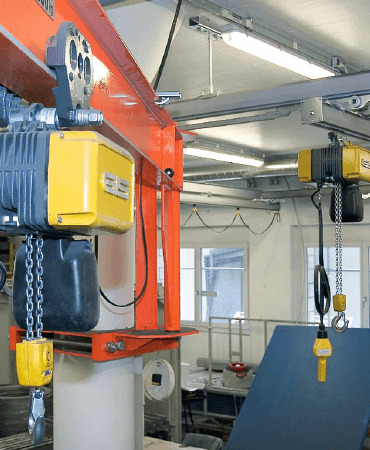
Benefits of Renting Top Notch Hoists:
Depending on one's needs, material hoists can be purchased in bulk from well-known suppliers for industrial or commercial utilisation. Additionally, this range of lifting equipment is highly recommended for construction sites. This equipment will move the goods with utmost safety and reduces physical labour while saving time. Moreover, skilled suppliers also mentioned that roofers, carpenters and decorators can also use this lifting equipment.
Professional suppliers offer diverse range of hoists that include transport platforms, mast climbing platforms, and other rope hoists that can easily relocate items. Furthermore, it could efficiently hold heavy weights and can reach up to maximum height (400 metres) while maintaining safety. Renowned companies also provide high quality spare parts for hoists consisting of top trusted brands depending on utilisation purposes.
Advantages of Buying Crane & Material Hoists:
Lifting equipment, cable reels, weight scales, and escalators are just few of the heavy-duty bearing tools available through the code of conduct.
In addition, they offer a varying range of balancers, vacuum lifts, and other equipment that makes heavy lifting and transporting objects simple.
Professionals provide a wide variety of robust machinery, such as vacuum lifters, material handlers, cable reels, spring balancers, and more.
One should enquire with the best suppliers if they want to buy or rent material hoists for better lifting performance.
Source
0 notes
Text
Winter Refit 2023-2024
This winter was spent in the water because we plan to be out of the water in the summer for a big job, but more on that below.
The tasks and improvements we did during this winter's refit were:
New Deck
When we bought Skyran we knew the original teak deck was nearing the end of its life. We wanted to replace it before any leaks developed causing bigger problems. So we made the commitment this year. The deck was templated in the autumn and, over the winter, a new deck was made for us This is to be professionally installed in a boatyard for us in early summer 2024. We decided to replace with a 'fake' teak to ease the maintenance burden in future years.


Removable Inner Forestay
Our mast is fitted for a cutter-rig. We decided some time ago to make use of this and install a halyard, stay and running backstays to make possible the use of a staysail and storm-staysail. This is because our headsail is a large overlapping genoa at present, challenging to handle in a big blow and obviously not the best shape when deeply reefed. For flexibility, we decided to make the inner stay removable. But first it was necessary to install a chain-plate to handle the structural loading. Having designed this and had it manufactured, we installed it in early 2024. We installed the inner stay and running backstays in late March. Very pleased with the results.


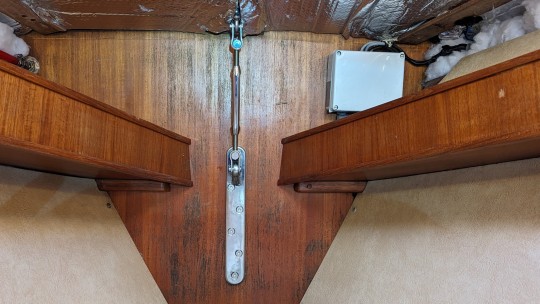
Electric Bilge Pumps
We completely replaced and upgraded the arrangements. We installed a new Whale gulper pump in the engine space, and a high-capacity Jabsco impeller pump for the main bilge. Both have solid-state level and alarm switches and completely independent power supplies and control switches with all new wiring. We created a neat new bilge pumps control panel too, and replaced quite a lot of the old hoses.
Water Meter
We installed a new meter, which is of the flow counting type. This is much more accurate than a tank level sensor that tells us exactly how many litres we have used. We measured the tanks using another flow counting meter so we know their exact capacity. The new water meter shows how many litres remain aboard, which is very handy indeed.

New Spray Hood & Canopy
We had replacements made for these. We will keep the older one for winters.

Electrical Improvements
We made a lot of improvements to the 12V DC system. Too many to list in detail, but the main items were:
Re-wired fridge and freezer systems, including relays. And fixed shore power supply to freezer.
Replaced choc-box terminals behind DC distribution panel with ring-screw terminals.
Re-designed and replaced un-switched distribution system, including fitting a Blue Sea Systems safety hub to remove multiple connections to the service batteries.
Installed marine rated battery fuses to protect cabling from service battery (there was no fusing before!). And installed fusing to other principal cables.
Removed and/or replaced many, many cables. All replacements made with tinned copper cabling.
Replaced gas alarm and sensors.
Installed WiFi router to broadcast navigation system data to mobile devices and computers.
Installed new 240V sockets adjacent to galley (for toaster and coffee machine :)
Miscellanious
We replaced the headsail furler line, with a larger diameter dyneema one to guard against failure when reefing in heavy weather.
We serviced the engine
We ordered wheels for the dinghy, to make it easier to haul it up slipways and beaches.
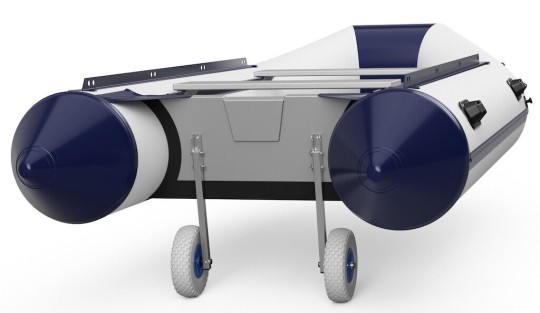
0 notes